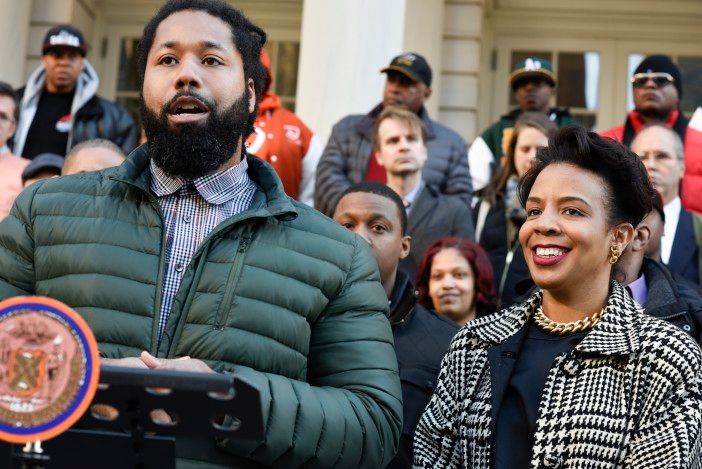CM Cumbo, City Council, And Anti-Gun Violence Groups Unite To Promote “Art A Catalyst For Change”


BY GEORGE GOSS
Several New York City Council members and dozens of activists are seeking to raise awareness—and money—for a program to end gun violence through art, Art A Catalyst For Change.
“Art has the power to change the lives of our young people.” said Councilmember Laurie Cumbo, who is one of those spearheading the project. “And I wanted that vision to come true through this particular initiative.”
Art A Catalyst For Change is to operate under the umbrella of the city’s Crisis Management System, a $19.5 million program funded by the Council—and De Blasio administration—to prevent gun violence throughout 18 neighborhoods, including our own Fort Greene and Clinton Hill. Approximately 24 art organizations that serve these areas and are associated with the Department of Cultural Affairs will use art to raise awareness about gun violence.
According to Cumbo, there have been 1,061 shooting incidents in New York City since the beginning of 2015, and more funds for this initiative can stop the violence. The Council recently allocated $720,000 for the program.
Eighteen groups will receive $648,000 to prepare posters, dance performances, poetry recitations and songs for a Gun Violence Awareness Month event in June. The remaining $72,000 is for the Hip-Hop Summit Youth Council, an advocacy group that works to steer teens away from gang violence, and will be presenting the event.

Ralph McDaniels, co-host of the hip-hop show “Video Music Box,” said that the space to create music was a privilege most of his peers did not have and that is why he supports this initiative for the next generation.
“Most of my friends that I grew up with are dead, in jail or on drugs,” McDaniels said. “But I had an opportunity to go into the arts.”
Cumbo said that growing up she would always watch “Video Music Box,” which featured hip-hop artists including Run D.M.C., LL Cool J, Queen Latifah and Will Smith.
“Too many of our men, women, and children are being killed for reasons that do not equal the value of a human life,” said Cumbo. “Through the arts, we can infuse resources to cultivate the hidden talents or untapped potential of our youth, establish a platform for self-expression, and diffuse the underlying issues that often lead to violent – in some cases, fatal conflicts.”
This program, she added, “is an opportunity to teach our youth how to funnel their energy into positive outlets for self-expression by placing down their guns and picking up paintbrushes, musical instruments, or styles of dance.”

The Reverend Kevin Jones of the Save Our Streets Clergy Action Network, a group that seeks to end gun violence in the Brooklyn neighborhoods of Crown Heights and Bedford-Stuyvesant through mediation and peer counseling, also supports the initiative.
At the press conference announcing the Art A Catalyst For Change funding push, Jones led a moment of silence for those afflicted by gun violence.
“Enough is enough,” Jones said. “Another gun shot, another life lost. And one life more is one life too many.”
Katora Jones, 20, of Mariners Harbor in Staten Island (no relation to the reverend) is one of those still living who lives with the loss every day. She lost her father to gun violence and her brother is currently serving time in prison for allegedly killing someone.
“Art is a great way to denounce violence,” Jones said. “It’s just hurts me to know that my brother is serving time when he really could be home with his family,” Jones said. “We go around showing documentaries on how after you’re involved in a shooting you could end up in the funeral parlor, jail or handicapped.”

Jeffrey Davis, the brother of the late James Davis, a councilman gunned down inside City Hall on July 23, 2003, also spoke in support of the project. Other supporters include the Hip-Hop Summit Youth Council, Life Camp, and Save Our Streets. Councilmembers Jumaane Williams, Robert Cornegy, Jimmy Van Bramer, Vanessa Gibson, Mark Levine, and Julissa Ferreras-Copeland are also in support of it.
Van Bramer noted that some people had raised their eyebrows at him and asked, “What does art have to do with gun violence? Or what does music have to do with inequality? Or theater with changing our culture?”
He said that all of those gathered there that day—the musicians, writers and theater producers—know that they have everything to do with each other. “We know that when children’s lives are embraced with art, culture and theater, they are empowered,” he said.
The campaign includes screenings of a film, “Triggering Wounds,” produced by the Maysles Documentary Center, which deals with the consequences of gun violence.
Blair Green, 24, and his guitar drove that message home. A student of the Brooklyn Music School, he played Caprice in D minor by Matteo Carcassi.
“The arts have magic, they have power and they have transformative effects that we cannot quantify,” Cumbo said.




